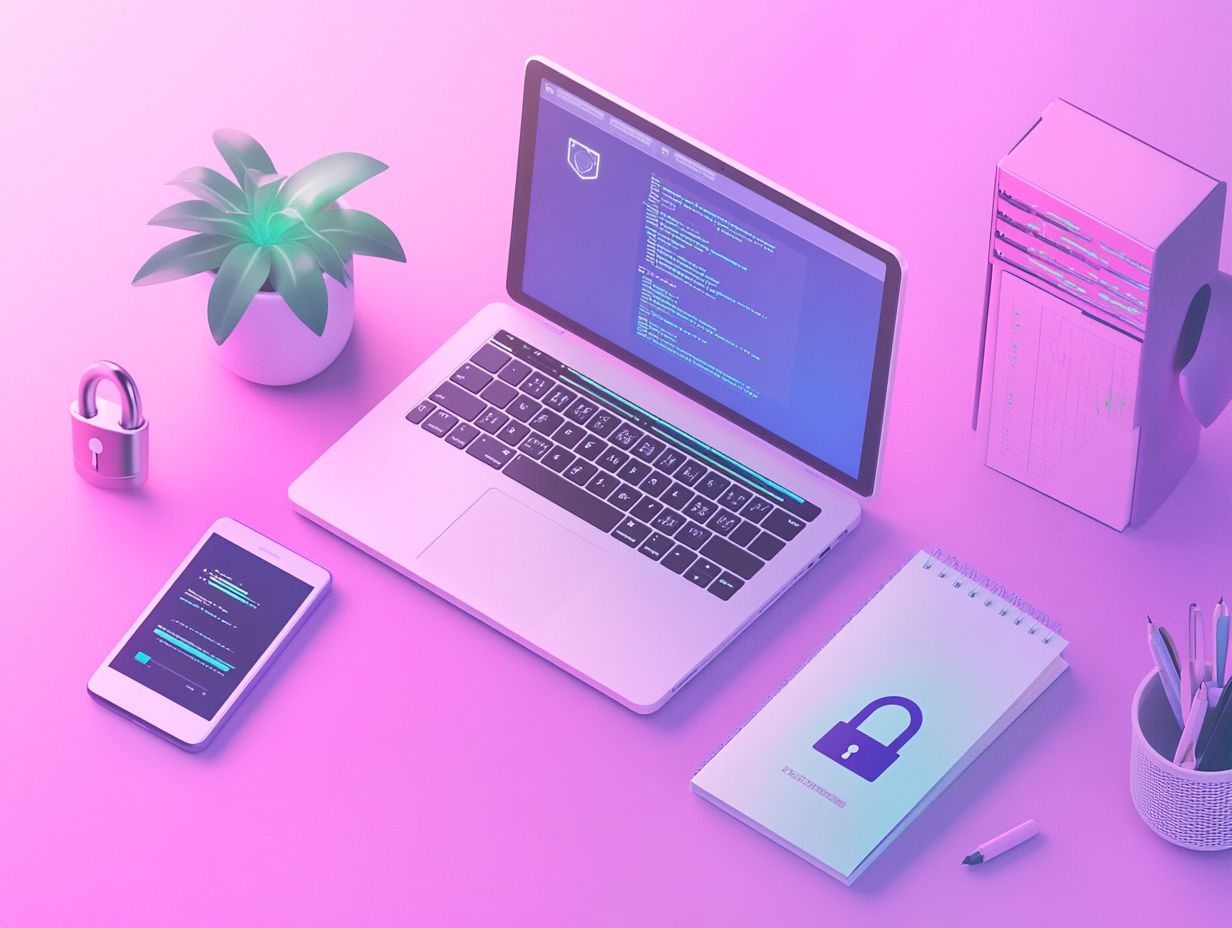what are the most effective cybersecurity tools?
In today s digital landscape, safeguarding your data has never been more critical. Cybersecurity tools are essential for protecting your organization from a myriad of threats. With a plethora of options at your disposal, selecting the right ones can feel daunting.
This article delves into various types of cybersecurity tools, such as antivirus software, firewalls, and encryption tools. It reviews the top tools available in the market and shares best practices for effective implementation to keep your organization secure.
Contents
- Key Takeaways:
- What are Cybersecurity Tools?
- Types of Cybersecurity Tools
- Factors to Consider When Choosing Cybersecurity Tools
- Top Cybersecurity Tools in the Market
- Implementing Cybersecurity Tools in Your Organization
- Frequently Asked Questions
- What are the most effective cybersecurity tools for small businesses?
- What are the most effective cybersecurity tools for large corporations?
- What are the most effective cybersecurity tools for personal use?
- What are the most effective cybersecurity tools for network security?
- What are the most effective cybersecurity tools for data protection?
- What are the most effective cybersecurity tools for cloud security?
Key Takeaways:

- Effective cybersecurity tools should include features like antivirus software, firewalls, intrusion detection systems, encryption tools, and vulnerability scanners.
- When choosing cybersecurity tools, factors such as cost, compatibility, user-friendliness, and effectiveness should be considered.
- Some top cybersecurity tools in the market include features such as advanced threat detection, real-time monitoring, and automated vulnerability management.
What are Cybersecurity Tools?
Cybersecurity tools include various software and hardware solutions. They protect systems, networks, and data from constantly changing cyber threats.
In a world where technology plays a pivotal role, understanding the significance of these tools is essential for both individuals and organizations.
Among these protective measures are:
- Antivirus Software
- Firewall Solutions
- Encryption Tools
These tools work in harmony to fortify defenses against malware, data breaches, and cybercrime. With digital threats on the rise, using effective cybersecurity tools is a must! They help keep your information safe and secure.
Types of Cybersecurity Tools
You ll find a diverse array of cybersecurity tools, each tailored to address distinct facets of digital security. They are designed to combat specific vulnerabilities and threats.
Antimalware and antivirus software stand guard against malicious software. Firewall solutions create a protective barrier between trusted and untrusted networks. Understanding the purpose and functionality of these tools is essential for achieving robust cybersecurity.
Furthermore, encryption tools are essential for safeguarding sensitive data. Intrusion detection systems monitor network traffic to spot suspicious activity, helping to catch threats early. Vulnerability scanning tools identify potential weaknesses in your security architecture.
Antivirus Software
Antivirus software is a cornerstone of cybersecurity. It detects, prevents, and eliminates malware from your computers and networks. These powerful tools scan files and programs for known threats, using signature-based detection, heuristic analysis, and behavioral detection methods.
As cybercrime grows more sophisticated, the importance of a robust antivirus solution cannot be overstated. It plays a crucial role in safeguarding the integrity and safety of your systems against data breaches and other malicious activities.
The effectiveness of your antivirus software depends significantly on its adaptability. By continuously updating virus definitions, it ensures that the latest threats are swiftly identified and neutralized, keeping you one step ahead of potential dangers.
Modern solutions leverage cutting-edge technologies like machine learning. This enhances detection accuracy by analyzing patterns and identifying potential threats even before they gain notoriety. This proactive approach significantly mitigates the risk of infection, protecting both your personal and organizational data.
To stay protected, ensure your antivirus software is always updated. Old definitions can leave your systems open to new malware threats.
Firewalls
Firewalls are your first line of defense. They create barriers between trusted and untrusted networks to shield against unauthorized access and cyber threats.
Firewalls filter traffic. This helps you maintain security compliance and protect sensitive data from malicious entities, making them important for your overall network security.
Each type of firewall has its own unique purpose. Hardware firewalls typically sit between your network and the gateway, offering robust protection against external attacks. Software firewalls operate directly on individual devices, providing a tailored approach to your security needs.
The effectiveness of firewalls depends on proper configuration. Misconfigured settings can create vulnerabilities that cybercriminals may exploit.
Integrating firewalls with other cybersecurity tools enhances their protective capabilities. This establishes a multi-layered defense that is crucial in today s complex cyber landscape.
Intrusion Detection Systems
Intrusion Detection Systems (IDS) are essential for your network security. They continuously monitor traffic for any suspicious activities or violations of policy.
By analyzing data packets, an IDS can alert you to possible breaches or attacks. This allows for a timely response to incidents, protecting your information systems from advanced persistent threats.
There are two primary types of Intrusion Detection Systems:
- Host-based IDS focuses on monitoring activities within a single server or device. It examines logs and system calls to detect unauthorized access or unusual behaviors.
- Network-based IDS assesses the traffic flowing across your entire network. It identifies malicious packets before they can inflict damage.
Both systems play critical roles in incident response. They enhance your situational awareness and provide invaluable forensic data. When combined with firewalls and antivirus software that detects malware, IDS forms a formidable layer of defense. This creates a comprehensive approach to cybersecurity that you can rely on.
Encryption Tools

Encryption tools are essential for safeguarding your sensitive information. They transform your data into formats that remain unreadable to unauthorized eyes.
By employing both software and hardware encryption techniques, these tools protect your data whether it s at rest or in transit. They ensure confidentiality and integrity against threats like data breaches and cybercrime.
With robust encryption algorithms, you can meet security policies and regulations such as GDPR (General Data Protection Regulation) and CCPA (California Consumer Privacy Act). This significantly bolsters your data security.
Choosing the right encryption methods is essential, as different types of data from personal information to corporate secrets require varying levels of protection.
Consider symmetric and asymmetric encryption methods, which serve unique purposes. For example, symmetric encryption uses the same key for both encoding and decoding. It is often preferred for its efficiency when handling large volumes of data. Conversely, asymmetric encryption utilizes a public-private key pair, making it ideal for secure communications such as email.
As more organizations transition to cloud-based solutions, choosing encryption tools that support cloud storage is crucial. This ensures that secure data transmission remains a priority, helping you maintain privacy and compliance.
Protect your data today with robust encryption tools and firewalls!
Vulnerability Scanners
Vulnerability scanners are important tools for your cybersecurity. They help identify and evaluate weak spots in your systems and networks.
By scanning for known weaknesses, misconfigurations, and outdated software, these tools empower you to address potential exploits proactively before cyber threats can target them.
Regular vulnerability scanning is vital for maintaining a strong network security posture and ensuring compliance with industry standards and regulations.
These scanners use comprehensive databases of vulnerabilities, allowing them to pinpoint a range of issues, from simple configuration errors to complex software flaws.
They play a crucial role in assessing both application and network-level risks, helping you prioritize your remediation efforts effectively.
Since the landscape of cyber threats is always changing, you must regularly update your scanning protocols to keep up with new threats and changes in your infrastructure.
Integrate vulnerability scanning into your cybersecurity strategy to enhance your defenses, reduce the risk of data breaches, and protect sensitive information from unauthorized access.
Factors to Consider When Choosing Cybersecurity Tools
When selecting the right cybersecurity tools, consider several crucial factors: cost, compatibility, user-friendliness, and overall effectiveness.
The financial investment for various cybersecurity solutions can vary greatly. Evaluate your budget constraints carefully.
These tools should integrate seamlessly with your existing systems and be easy to use, ensuring that cybersecurity professionals can utilize them efficiently.
Ultimately, their ability to prevent data breaches and protect against cyber threats will determine their value.
Cost
The cost of cybersecurity tools is a critical factor in your security strategies. With various solutions available from free open-source options to premium software understanding your budget implications is essential for effective resource allocation.
Assessing the potential return on investment (ROI) regarding improved security and reduced risk of data breaches can guide your decisions.
When evaluating costs, consider not just the initial purchase prices but also ongoing expenses like maintenance, updates, and training.
Analyze how these costs compare to expected benefits, such as enhanced protection from threats, compliance with regulations, and peace of mind for your stakeholders.
By examining historical data and industry benchmarks, you can better understand the long-term financial impacts of your cybersecurity choices.
Engage with security experts for valuable insights into best practices and tool effectiveness. This ensures you find the right balance between spending and benefits.
Compatibility
The compatibility of cybersecurity tools with your existing systems and software is essential for effective security measures. When tools integrate seamlessly into your environment, they reduce disruptions and enhance operational efficiency.
Consider compatibility not only with your hardware and software but also with any other security measures you have in place. This creates a cohesive security framework.
Without thorough testing, you may face unexpected challenges, such as system downtime, data loss, or even security breaches. These issues can lead to increased costs, strained resources, and a loss of trust among stakeholders.
Prioritize compatibility assessments before full-scale implementation. This allows you to identify potential conflicts and address them effectively.
Investing time in compatibility testing lays the groundwork for a stronger and more secure operational environment.
Top Cybersecurity Tools in the Market
The market brims with a multitude of cybersecurity tools. Yet, a select few rise above the rest due to their exceptional features, proven effectiveness, and trusted reputation among cybersecurity experts.
These premier tools tackle diverse facets of cybersecurity, ranging from malware protection to incident response, empowering organizations to effectively mitigate risks.
Understanding the unique features and advantages of these tools is crucial for choosing the right solutions tailored to your specific security requirements.
Effectiveness
The effectiveness of cybersecurity tools in detecting and responding to threats is crucial for maintaining a secure environment. Evaluate the performance of these tools using metrics such as how well they find harmful software, response times, and their ability to adapt to emerging threats.
Continuous assessment and updates are vital to ensure that these tools remain effective against evolving digital challenges, which is essential for long-term security. Gathering user reviews can provide invaluable insights into real-world performance and usability.
Conducting rigorous tests in controlled environments allows you to assess various tools under different scenarios. This reveals strengths and weaknesses that might not be immediately obvious. Incorporating case studies from reputable sources offers practical examples of how specific solutions have performed against particular threats, demonstrating their relevance in today s rapidly changing landscape.
Staying updated with the latest cyber threats is crucial. Even the best tools can stumble without regular adjustments and improvements.
User-Friendliness
User-friendliness should be at the forefront when selecting cybersecurity tools. Intuitive and easy-to-navigate tools help your cybersecurity professionals spend less time on training and more time adapting to the landscape.
This leads to more efficient threat detection and response. Using user-friendly interfaces can significantly boost your team s productivity while minimizing human error.
For example, platforms like Splunk and Palo Alto Networks offer dashboards crafted with user experience in mind. Even less experienced staff can effectively monitor and interpret security data.
By streamlining processes and making critical information readily accessible, these tools empower your team to respond to incidents promptly, significantly reducing the risk of breaches.
User-friendly security training simulations, such as those offered by KnowBe4, enhance understanding through realistic scenarios without overwhelming learners. Ultimately, prioritizing usability equips your cybersecurity teams with essential skills and fosters a culture of proactive security awareness within your organization.
Features and Benefits of Each Tool
Each top cybersecurity tool offers a distinct array of features and benefits, specifically designed to tackle unique security challenges. You ll find everything from advanced malware protection and robust encryption capabilities to intuitive interfaces and automated incident response.
These tools deliver comprehensive solutions to combat cyber threats. Understanding their features enables you to select the most effective tools that align with your security policies and operational requirements.
The adaptability of these tools in real-world scenarios significantly enhances their value. For example, one leading company recently reported that by implementing an advanced threat detection tool, they slashed their incident response time by 30%. This improvement expedited their risk mitigation efforts and strengthened customer trust.
Another organization integrated a data loss prevention solution, leading to a marked decline in compliance violations. These testimonials highlight the tangible benefits of employing the right cybersecurity tools, empowering organizations to protect their data while maintaining operational integrity.
Implementing Cybersecurity Tools in Your Organization
Implementing cybersecurity tools in your organization demands careful planning and a commitment to best practices for optimal effectiveness and security.
Adopt a structured approach to integrate these tools into your existing security frameworks, ensuring compatibility and ease of use.
Establishing clear security measures is essential for compliance with industry regulations. This helps mitigate risks and enables effective responses to cyber threats.
Best Practices and Tips
Adopting best practices when implementing cybersecurity tools is crucial for compliance and effective incident response. Establish a comprehensive security policy that outlines the roles of each tool and procedures for responding to potential threats.
Regular training is crucial! It’s your frontline defense against ever-evolving cyber threats.
Conducting assessments and simulations strengthens defenses by identifying vulnerabilities within your systems and refining response strategies. Collaboration among teams is key; fostering a culture of communication ensures everyone is aligned regarding security measures.
Integrating the latest threat intelligence keeps you informed about emerging risks, while engaging with third-party cybersecurity experts for audits provides valuable insights that your internal teams might overlook.
Ultimately, committing to continuous education and leveraging community resources significantly enhances your overall cybersecurity posture.
Frequently Asked Questions
-
What are the most effective cybersecurity tools for small businesses?
Some effective cybersecurity tools for small businesses include firewalls, antivirus software, and employee training programs. These tools help protect against common cyber threats and vulnerabilities.
-
What are the most effective cybersecurity tools for large corporations?
Large corporations may benefit from advanced cybersecurity tools such as intrusion detection systems, vulnerability scanners, and Security Information and Event Management (SIEM) systems. These tools detect and respond to sophisticated cyber attacks.
-
What are the most effective cybersecurity tools for personal use?
For personal use, it is recommended to have strong antivirus software, a secure password manager, and a virtual private network (VPN) to protect against online threats and maintain online privacy.
-
What are the most effective cybersecurity tools for network security?
To ensure network security, organizations can utilize tools such as network intrusion detection systems, network firewalls, and secure web gateways. These tools monitor and protect network traffic from potential cyber attacks.
-
What are the most effective cybersecurity tools for data protection?
Data protection is a critical aspect of cybersecurity. Organizations can use tools such as data encryption software, data loss prevention tools, and secure file sharing platforms to safeguard sensitive information.
-
What are the most effective cybersecurity tools for cloud security?
As more businesses move their data and applications to the cloud, effective cybersecurity tools are essential. Some tools that can help secure cloud environments include cloud access security brokers, identity and access management systems, and cloud encryption tools.








